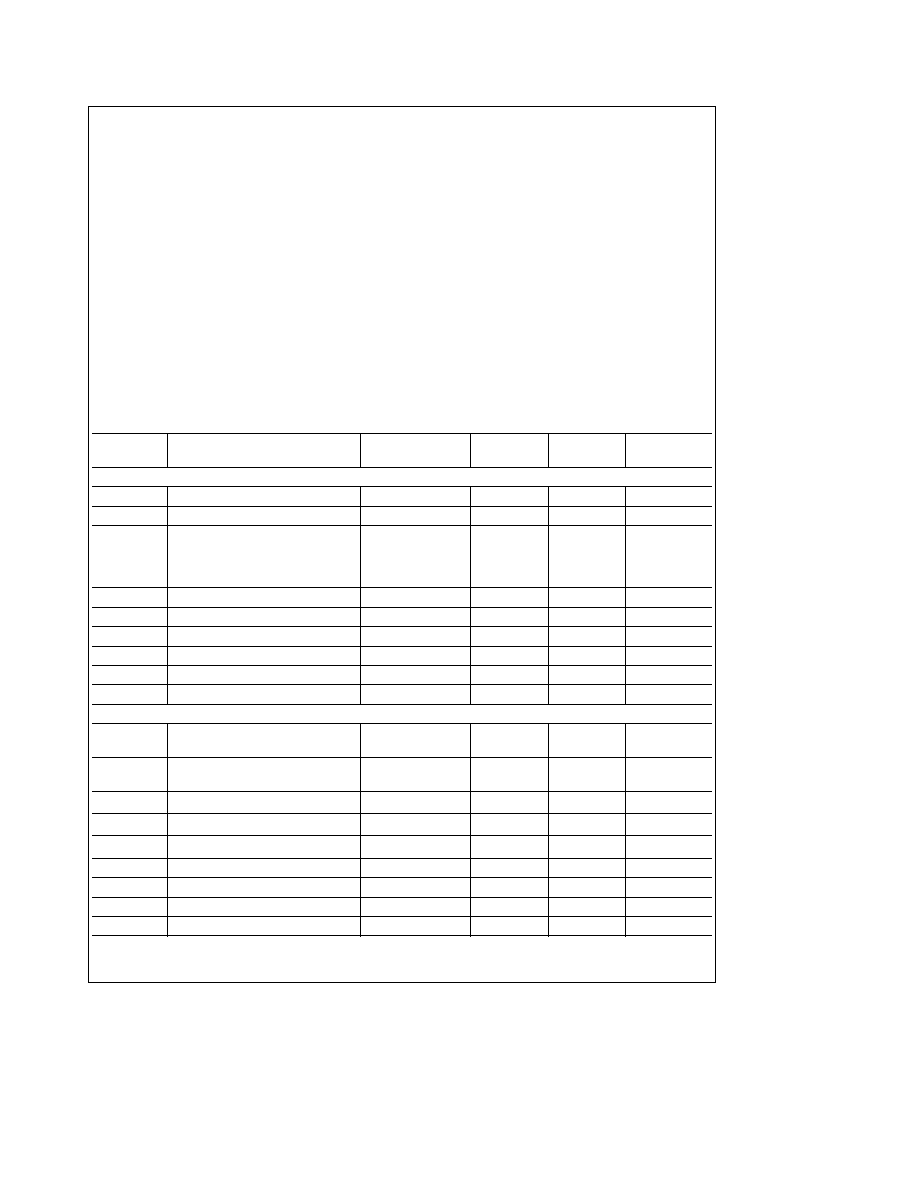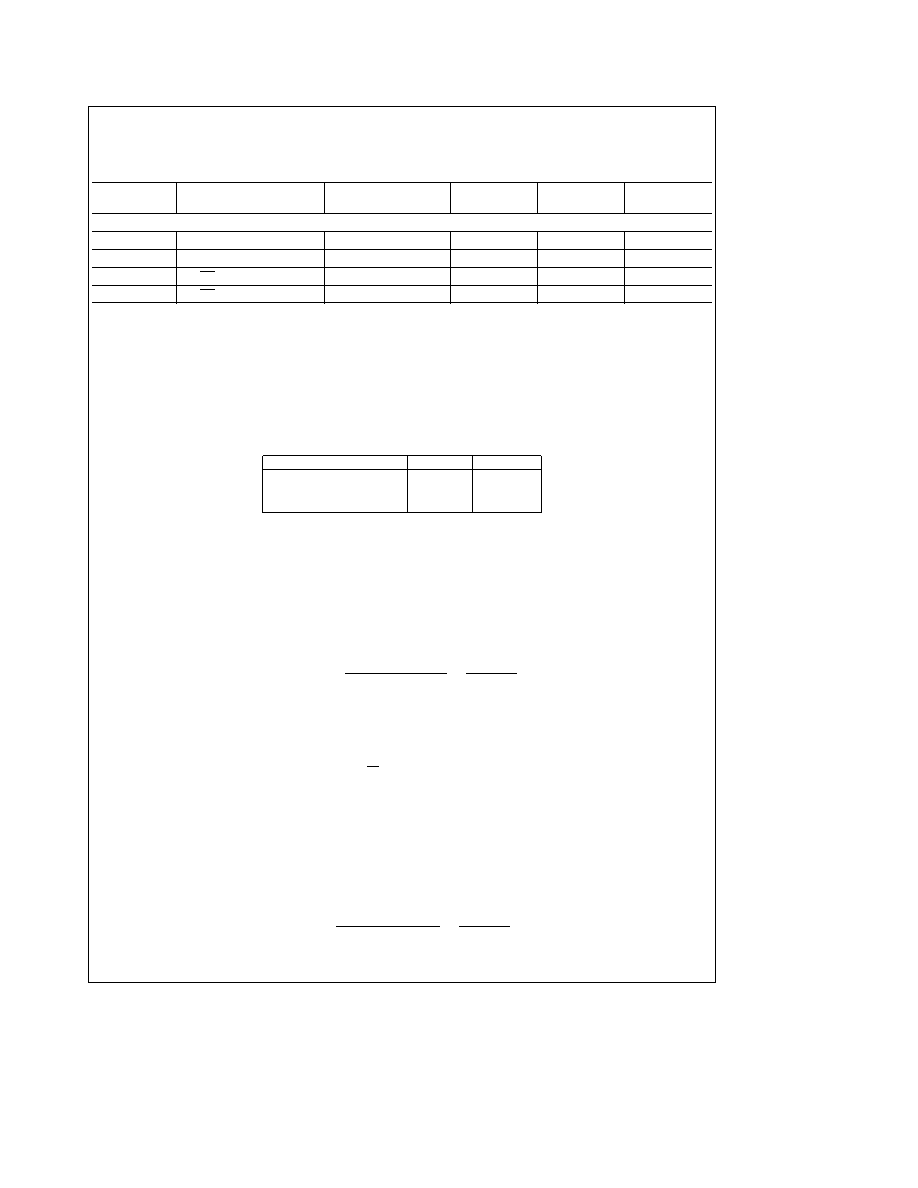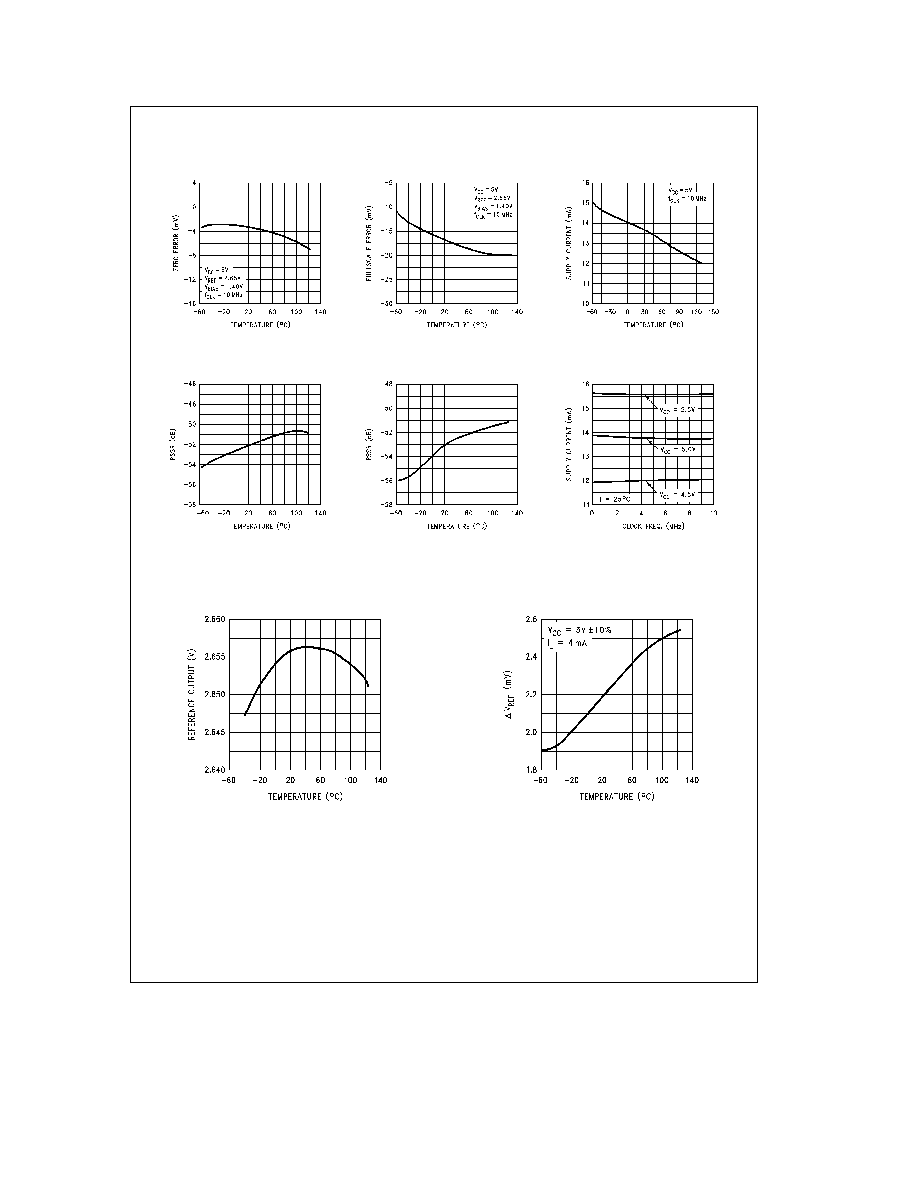
TL H 11261
DAC0854
Quad
8-Bit
Voltage-Output
Serial
DA
Converter
with
Readback
January 1995
DAC0854 Quad 8-Bit Voltage-Output
Serial D A Converter with Readback
General Description
The DAC0854 is a complete quad 8-bit voltage-output digi-
tal-to-analog converter that can operate on a single 5V sup-
ply It includes on-chip output amplifiers internal voltage ref-
erence and a serial microprocessor interface By combining
in one package the reference amplifiers and conversion
circuitry for four D A converters the DAC0854 minimizes
wiring and parts count and is hence ideally suited for appli-
cations where cost and board space are of prime concern
The DAC0854 also has a data readback function which can
be used by the microprocessor to verify that the desired
input word has been properly latched into the DAC0854's
data registers The data readback function simplifies the de-
sign and reduces the cost of systems which need to verify
data integrity
The logic comprises a MICROWIRE
TM
-compatible serial in-
terface and control circuitry The interface allows the user to
write to any one of the input registers or to all four at once
The latching registers are double-buffered consisting of 4
separate input registers and 4 DAC registers Double buffer-
ing allows all 4 DAC outputs to be updated simultaneously
The four reference inputs allow the user to configure the
system to have a separate output voltage range for each
DAC The output voltage of each DAC can range between
0 3V and 2 8V and is a function of V
BIAS
V
REF
and the
input word
Features
Y
Single
a
5V supply operation
Y
MICROWIRE serial interface allows easy interface to
many popular microcontrollers including the COPS
TM
and HPC
TM
families of microcontrollers
Y
Data readback capability
Y
Output data can be formatted to read back MSB or
LSB first
Y
Versatile logic allows selective or global update of the
DACs
Y
Power fail flag
Y
Output amplifiers can drive 2 kX load
Y
Synchronous asynchronous update of the DAC outputs
Key Specifications
Y
Guaranteed monotonic over temperature
Y
Integral linearity error
g
LSB max
Y
Output settling time
2 7 ms max
Y
Analog output voltage range
0 3V to 2 8V
Y
Supply voltage range
4 5V to 5 5V
Y
Clock frequency
10 MHz max
Y
Power dissipation (f
CLK
e
10 MHz)
95 mW max
Y
On-board reference
2 65V
g
2% max
Applications
Y
Automatic test equipment
Y
Industrial process controls
Y
Automotive controls and diagnostics
Y
Instrumentation
Connection Diagram
TL H 11261 ≠ 1
Top View
Ordering Information
Industrial (
b
40 C
k
T
A
a
85 C)
Package
DAC0854BIN DAC0854CIN
N20A Molded DIP
DAC0854CIJ
J20A Ceramic DIP
DAC0854BIWM DAC0854CIWM
M20B Small Outline
Military (
b
55 C
k
T
A
k
a
125 C)
DAC0854CMJ 883
J20A Ceramic DIP
COPS
TM
HPC
TM
and MICROWIRE
TM
are trademarks of National Semiconductor Corporation
C1995 National Semiconductor Corporation
RRD-B30M75 Printed in U S A

Absolute Maximum Ratings
(Notes 1
2)
If Military Aerospace specified devices are required
please contact the National Semiconductor Sales
Office Distributors for availability and specifications
(Note 24)
Supply Voltage (AV
CC
DV
CC
)
7V
Supply Voltage Difference (AV
CC
≠ DV
CC
)
g
5 5V
Voltage at Any Pin (Note 3)
GND
b
0 3V to
AV
CC
DV
CC
a
0 3V
Input Current at Any Pin (Note 3)
5 mA
Package Input Current (Note 4)
20 mA
Power Dissipation (Note 5)
105 mW
ESD Susceptibility (Note 6)
1250V
Soldering Information
J Package (10 sec )
300 C
N Package (10 sec )
260 C
SO Package
Vapor Phase (60 sec )
215 C
Infrared (15 sec ) (Note 7)
220 C
Storage Temperature
b
65 C to
a
150 C
Operating Ratings
(Notes 1
2)
Supply Voltage
4 5V to 5 5V
Supply Voltage Difference (AV
CC
b
DV
CC
)
g
IV
Temperature Range
T
MIN
k
T
A
k
T
MAX
DAC0854BIN DAC0854CIN
DAC0854CIJ DAC0854BIWM
DAC0854CIWM
b
40 C
k
T
A
k
85 C
DAC0854CMJ 883
b
55 C
k
T
A
k
125 C
Converter Electrical Characteristics
The following specifications apply for AV
CC
e
DV
CC
e
5V V
REF
e
2 65V V
BIAS
e
1 4V R
L
e
2 kX (R
L
is the load resistor on
the analog outputs ≠ pins 1 11 14 and 19) and f
CLK
e
10 MHz unless otherwise specified Boldface limits apply for T
A
e
T
J
from T
MIN
to T
MAX
All other limits apply for T
A
e
25 C
Symbol
Parameter
Conditions
Typical
Limit
Units
(Note 8)
(Note 9)
(Limits)
STATIC CHARACTERISTICS
n
Resolution
f
CLK
e
10 MHz
8
8
bits
Monotonicity
(Note 10)
8
8
bits
Integral Linearity Error
(Note 11)
DAC0854BIN DAC0854BIWM
g
0 5
LSB (max)
DAC0854CIN DAC0854CIJ
DAC0854CIWM DAC0854CMJ
g
1 0
LSB (max)
Differential Linearity Error
g
1 0
LSB (max)
Fullscale Error
(Note 12)
g
35
mV
Fullscale Error Tempco
(Note 13)
b
30
ppm C
Zero Error
(Note 14)
g
35
mV
Zero Error Tempco
(Note 13)
b
30
ppm C
Power Supply Sensitivity
(Note 15)
b
42
b
34
dB (max)
DYNAMIC CHARACTERISTICS
t
sa
Positive Voltage Output
(Note 16)
1 5
2 1
m
s
Settling Time
C
L
e
200 pF
t
sb
Negative Voltage Output
(Note 16)
1 8
2 7
m
s
Settling Time
C
L
e
200 pF
Digital Crosstalk
(Note 17)
1 8
mV
p-p
Digital Feedthrough
(Note 18)
8 5
mV
p-p
Clock Feedthrough
(Note 19)
3 3
mV
p-p
Channel-to-Channel Isolation
(Note 20)
b
78
dB
Glitch Energy
(Note 21)
7
nV
b
s
Peak Value of Largest Glitch
38
mV
PSRR
Power Supply Rejection Ratio
(Note 22)
b
49
dB
2

Converter Electrical Characteristics
(Continued)
The following specifications apply for AV
CC
e
DV
CC
e
5V V
REF
e
2 65V V
BIAS
e
1 4V R
L
e
2 kX (R
L
is the load resistor on
the analog outputs ≠ pins 1 11 14 and 19) and f
CLK
e
10 MHz unless otherwise specified Boldface limits apply for T
A
e
T
J
from T
MIN
to T
MAX
All other limits apply for T
A
e
25 C
Symbol
Parameter
Conditions
Typical
Limit
Units
(Note 3)
(Note 4)
(Limits)
DIGITAL AND DC ELECTRICAL CHARACTERISTICS
V
IN(1)
Logical ``1'' Input Voltage
AV
CC
e
DV
CC
e
5 5V
2 0
V (min)
V
IN(0)
Logical ``0'' Input Voltage
AV
CC
e
DV
CC
e
4 5V
0 8
V (max)
I
IL
Digital Input Leakage Current
1
5
m
A (max)
C
IN
Input Capacitance
4
pF
C
OUT
Output Capacitance
5
pF
V
OUT(1)
Logical ``1'' Output Voltage
I
SOURCE
e
0 8 mA
2 4
V (min)
V
OUT(0)
Logical ``0'' Output Voltage
I
SINK
e
3 2 mA
0 4
V (max)
V
INT
Interrupt Pin Output Voltage
10 kX Pullup
0 4
V (max)
I
S
Supply Current
Outputs Unloaded
14
19
mA
REFERENCE INPUT CHARACTERISTICS
V
REF
Input Voltage Range
0 ≠ 2 75
V
R
REF
Input Resistance
7
4
kX (min)
10
kX (max)
C
REF
Input Capacitance
Full-Scale Data Input
40
pF
V
BIAS
INPUT CHARACTERISTICS
V
BIAS
V
BIAS
Input Voltage Range
0 3 ≠ 1 4
V
Input Leakage
1
m
A
C
BIAS
Input Capacitance
9
pF
BANDGAP REFERENCE CHARACTERISTICS
(C
L
e
220mF)
V
REF
OUT
Output Voltage
2 65
g
2%
V
D
V
REF
D
T
Tempco
(Note 23)
22
ppm C
Line Regulation
4 5V
k
V
CC
k
5 5V I
L
e
4 mA
2
5
mV
D
V
REF
D
I
L
Load Regulation
0
k
I
L
k
4 mA
2
6
mV
0
k
I
L
k
4 mA CMJ Suffix
2
15
mV
b
1
k
I
L
k
0 mA
2 5
mV
I
SC
Short Circuit Current
V
REF
OUT
e
0V
12
mA
AC ELECTRICAL CHARACTERISTICS
t
DS
Data Setup Time
10
ns (min)
t
DH
Data Hold Time
0
ns (min)
t
CS
Control Setup Time
15
ns (min)
t
CH
Control Hold Time
0
ns (min)
t
MIN
Clock Frequency
10
MHz (max)
t
H
Minimum Clock High Time
20
ns (min)
t
L
Minimum Clock Low Time
40
ns (min)
3

Converter Electrical Characteristics
(Continued)
The following specifications apply for AV
CC
e
DV
CC
e
5V V
REF
e
2 65V V
BIAS
e
1 4V R
L
e
2 kX (R
L
is the load resistor on
the analog outputs ≠ pins 1 11 14 and 19) and f
CLK
e
10 MHz unless otherwise specified Boldface limits apply for T
A
e
T
J
from T
MIN
to T
MAX
All other limits apply for T
A
e
25 C
Symbol
Parameter
Conditions
Typical
Limit
Units
(Note 3)
(Note 4)
(Limits)
AC ELECTRICAL CHARACTERISTICS
(Continued)
t
CZ1
Output Hi-Z to Valid 1
37
ns (max)
t
CZ0
Output Hi-Z to Valid 0
42
ns (max)
t
1H
CS to Output Hi-Z
10 kX with 60 pF
130
ns (max)
t
0H
CS to Output Hi-Z
10 kX with 60 pF
117
ns (max)
Note 1
Absolute Maximum Ratings indicate limits beyond which damage to the device may occur Operating Ratings indicate conditions for which the device is
functional These ratings do not guarantee specific performance limits however For guaranteed specifications and test conditions see the Converter Electrical
Characteristics The guaranteed specifications apply only for the test conditions listed Some performance characteristics may degrade when the device is not
operated under the listed test conditions
Note 2
All voltages are measured with respect to ground unless otherwise specified
Note 3
When the input voltage (V
IN
) at any pin exceeds the power supply rails (V
IN
k
GND or V
IN
l
V
a
) the absolute value of current at that pin should be limited
to 5 mA or less
Note 4
The sum of the currents at all pins that are driven beyond the power supply voltages should not exceed 20 mA
Note 5
The maximum power dissipation must be derated at elevated temperatures and is dictated by T
Jmax
(maximum junction temperature) H
JA
(package junction to ambient thermal resistance)
and T
A
(ambient temperature)
The maximum allowable power dissipation at any temperature is
P
Dmax
e
(T
Jmax
b
T
A
) H
JA
or the number given in the Absolute Maximum Ratings whichever is lower The table below details T
Jmax
and H
JA
for the various
packages and versions of the DAC0854
Part Number
T
Jmax
( C)
H
JA
( C W)
DAC0854BIN DAC0854CIN
125
46
DAC0854BIJ DAC0854CIJ
125
53
DAC0854BIWM DAC0854CIWM
125
64
DAC0854CMJ 883
150
53
Note 6
Human body model 100 pF discharged through a 1 5 kX resistor
Note 7
See AN450 ``Surface Mounting Methods and Their Effect on Production Reliability'' of the section titled ``Surface Mount'' found in any current Linear
Databook for other methods of soldering surface mount devices
Note 8
Typicals are at T
J
e
25 C and represent most likely parametric norm
Note 9
Limits are guaranteed to National's AOQL (Average Outgoing Quality Level)
Note 10
A monotonicity of 8 bits for the DAC0854 means that the output voltage changes in the same direction (or remains constant) for each increase in the input
code
Note 11
Integral linearity error is the maximum deviation of the output from the line drawn between zero and full-scale (excluding the effects of zero error and full-
scale error)
Note 12
Full-scale error is measured as the deviation from the ideal 2 800V full-scale output when V
REF
e
2 650V and V
BIAS
e
1 400V
Note 13
Full-scale error tempco and zero error tempco are defined by the following equation
Error tempco
e
Error (T
MAX
)
b
Error (T
MIN
)
V
SPAN
(
10
6
T
MAX
b
T
MIN
(
where Error (T
MAX
) is the zero error or full-scale error at T
MAX
(in volts) and Error (T
MIN
) is the zero error or full-scale error at T
MIN
(in volts) V
SPAN
is the output
voltage span of the DAC0854 which depends on V
BIAS
and V
REF
Note 14
Zero error is measured as the deviation from the ideal 0 310V output when V
REF
e
2 650V V
BIAS
e
1 400V and the digital input word is all zeros
Note 15
Power Supply Sensitivity is the maximum change in the offset error or the full-scale error when the power supply differs from its optimum 5V by up to
0 25V (5%) The load resistor R
L
e
5 kX
Note 16
Positive or negative settling time is defined as the time taken for the output of the DAC to settle to its final full-scale or zero output to within
g
0 5 LSB
This time shall be referenced to the 50% point of the positive edge of CS which initiates the update of the analog outputs
Note 17
Digital crosstalk is the glitch measured on the output of one DAC while applying an all 0s to all 1s transition at the input of the other DACs
Note 18
All DACs have full-scale outputs latched and DI is clocked with no update of the DAC outputs The glitch is then measured on the DAC outputs
Note 19
Clock feedthrough is measured for each DAC with its output at full-scale The serial clock is then applied to the DAC at a frequency of 10 MHz and the
glitch on each DAC full-scale output is measured
Note 20
Channel-to-channel isolation is a measure of the effect of a change in one DAC's output on the output of another DAC The V
REF
of the first DAC is varied
between 1 4V and 2 65V at a frequency of 15 kHz while the change in full-scale output of the second DAC is measured The first DAC is loaded with all 0s
Note 21
Glitch energy is the difference between the positive and negative glitch areas at the output of the DAC when a 1 LSB digital input code change is applied
to the input The glitch energy will have its largest value at one of the three major transitions The peak value of the maximum glitch is separately specified
Note 22
Power Supply Rejection Ratio is measured by varying AV
CC
e
DV
CC
between 4 75V and 5 25V with a frequency of 10 kHz and measuring the proportion
of this signal imposed on a full-scale output of the DAC under consideration
Note 23
The bandgap reference tempco is defined by the following equation
Tempco
e
V
REF
(T
MAX
)
b
V
REF
(T
MIN
)
V
REF
(T
ROOM
)
(
10
6
T
MAX
b
T
MIN
(
where T
ROOM
e
25 C V
REF
(T
MAX
) is the reference output at T
MAX
and similarly for V
REF
(T
MIN
) and V
REF
(T
ROOM
)
Note 24
A Military RETS specification is available upon request
4




